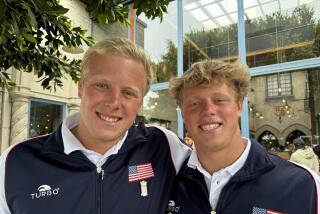They’ve Got Next
- Share via
Pete Sampras is gone. Michael Chang, too. Jim Courier left before either of them. Todd Martin thinks about retirement all the time. Andre Agassi presses on, but at age 33 he knows the next stage of his life is fast approaching.
This era of great American men’s tennis players is reaching the end of its run, much the way John McEnroe and Jimmy Connors did a decade or so ago. But the replacement parts are already in place.
Andy Roddick, who once hid in the players’ lounge at the U.S. Open to watch the big-name players pass by, and James Blake, who took his game from Harlem to Harvard, played high quality tennis on center court at the Open.
Robby Ginepri reached the third round of America’s Grand Slam. Taylor Dent played into the second week. Mardy Fish and Jan-Michael Gambill still have their best tennis ahead of them.
Sampras was asked about the next group of American players.
“I think we’re in good shape,” he said at the start of the Open. “Roddick has taken it to a new level now. James Blake and Mardy Fish, guys are starting to catch on a little bit. To duplicate what Andre and I did, Jim and Michael, it’s going to be tough. I mean there’s a lot of majors (27 Grand Slams among them) there. But I think it’s in pretty good shape.”
The new guys have been heralded for some time. Now, it is their time.
“We’re to the point where we’re contenders for titles,” Blake said. “I feel like I have the possibility to get hot for a week or two weeks in a Grand Slam. We’ve got guys who can really play.”
They are America’s Next Generation, massaged and managed by the player development division of the USTA.
“Roddick made the breakthrough, Ginepri and Fish and Blake are next,” said Dr. Paul Roetert, managing director of USTA tennis high performance. “They’ve come together at the same time and they will push each other. That’s good for all four of them. We’ve helped each of them at different stages.”
Now they are established and on their own and so Roetert thinks about the next Next Generation, a cluster of kids working their way up through the junior ranks.
He rattles off the names -- Donald Young, Leo Rosenberg, Dennis Lajola on the boys’ side; Bethanie Mattek, Ally Baker and Ashley Harkleroad on the girls’ side.
Young and Rosenberg produced the doubles victory that gave the United States the world junior championships over Japan earlier this year. Harkleroad and Mattek won the Continental Cup in 2000 and both were in the main draw at the Open. Harkleroad even won a match. She may be a step ahead of the others but they are all in the fast lane.
Mattek was seeded No. 1 in the Open juniors tournament, an event once won by Jennifer Capriati and Lindsay Davenport.
“It’s my first time to be seeded No. 1 in an ITF event, and to be seeded No. 1 in the junior U.S. Open is really a big deal,” she said.
“It’s quite a promising future,” Roetert said. “We want them competing with each other as well as with foreign players. We are a year or two away from the next group’s breakthrough.”
Predicting the future for the youngsters is a tricky bit of business. Sampras never won a national championship in junior tennis but nobody won more Grand Slams than he did. Martin, who contributes time as a USTA junior coach, was an ordinary player at that stage of his career. As he got older, he became more of a factor.
Besides Martin, Zina Garrison, Patrick McEnroe and Billie Jean King work with the young players. As captains of the Davis Cup and Fed Cup teams, McEnroe and King have a vested interest in the development of the young players.
“We have 16 full-time coaches, eight men and eight women,” Roetert said. “They are former professional players and some of the best coaches in the world. They share a philosophy of coaching that runs through the 17 sections where the USTA oversees the development of young players.
“Our future is very promising,” Roetert said. “I can’t wait to see them on the big stage here.”
More to Read
Go beyond the scoreboard
Get the latest on L.A.'s teams in the daily Sports Report newsletter.
You may occasionally receive promotional content from the Los Angeles Times.










